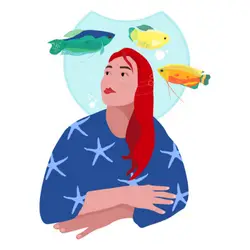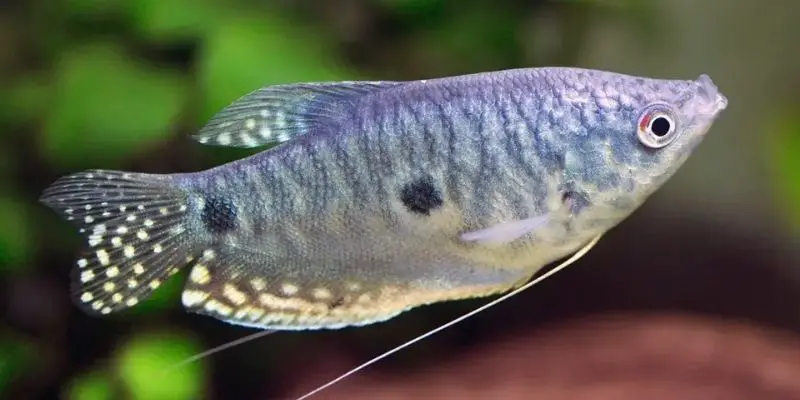I’m so excited to write about breeding three spot gourami! I just successfully bred my first batch of fry, and I want to share everything I learned with you. In this post, I’ll cover how to sex your fish, choose a breeding pair, and care for the eggs and fry. Let’s get started!
The Beginning
My breeding project started when a friend gave me a group of three spot gourami that she couldn’t keep. My 200-gallon aquarium was the best option for housing them temporarily, and I set up a 10-gallon tank to serve as their breeding ground.
I knew from doing some online research that three spot gourami are bubble nest builders, so I bought a plastic plant basket to provide them with the necessary spawning site. The basket also helped me keep track of which fish was a parent and which was a child.
The breeding tank is set up exactly like the display tank that housed my gourami before they were separated:
- Water temperature: 76-78 degrees Fahrenheit
- PH: 7.2-7.4
My five fish are still young, so I’m not sure how to sex them yet. They all have the typical long and bubble-like fins of mature males, but I haven’t noticed any other differences between the sexes yet. To help me tell my boys from their girls, I decided to give my fish age-appropriate names. Meet Jack, Finn, and Jake!
I keep the parents in their tank to prevent any accidental spawning or damage that could be caused by an overly-aggressive suitor. They are given a diet of flake food with occasional treats like brine shrimp (for protein) and bloodworms (for color enhancement).
My Breeding Method
To breed my fish, I followed a very simple five-step process:
- Condition the pair
- Introduce them to their new tank
- Feed them well
- Perform a 75% water change
- Check for eggs!
Conditioning the Pair
Conditioning the pair is relatively straightforward. I gradually introduced the parents to their new home by putting them in for increasingly longer periods of time, giving them clean water before moving on to cloudy water, and finally releasing them into their tank permanently.
Introduce Them to Their New Home
After about a week of “conditioning,” it was time to introduce the pair to their new home. I didn’t notice any breeding activity during this time, but that’s okay because it gave them a chance to get used to the new setup before they started trying to breed.
Feed Them Well
I feed my fish twice per day–in the morning and early evening (around 6-7 pm). I keep the morning treat to a small breakfast of freeze-dried brine shrimp and bloodworms. The evening meal is a heaping helping of Hikari Tropical Sinking Wafers for my herbivores, Hikari Algae Wafers for my omnivore/scavengers (i.e., Jake), and algae wafers to provide veggies for my omnivore/algae-scrapers (i.e., Finn).
Perform a 75% Water Change
This step can be performed any time after the pair have been conditioned, but the sooner you complete the process, the better off your fish will be. I recommend doing this on day four or five of conditioning. The fish will be used to live in your breeding tank by this time, and the water change will clear out any uneaten food and waste that may contribute to ammonia spikes.
Check for Eggs
I check my fish every day to make sure they look healthy and happy!
It also gives me a chance to see if any eggs have been laid. After checking for eggs, I immediately siphon out the bottom of the tank to remove them. It’s important to remove these as soon as possible. If they aren’t removed, they can turn into fungus gnats and infest your entire tank!
After removing the unhatched eggs, everything is back in working order and it’s time to wait.
The Wait
I monitored both parents for signs of spawning every day but didn’t see anything until the afternoon on the sixth day. Finn started acting very aggressive toward Jack, and I saw them spawn in a bubble nest that Finn had made himself!
Finn and Jack don’t have any tank decorations in the form of plants or hides, so Finn made himself a bubble nest using an old bit of glass sponge I had in my tank. He took it upon himself to chew off pieces of the glass sponge and spit them out into the water, creating his own little bubble-nest fort!
A few hours later, Jake came by to check out the action. Finn chased him away, but it’s okay because Jake won’t eat brooding fish and he doesn’t bother them when they’re spawning anyways.
Since they spawned right on day six, I’m going to keep a closer eye on them for the next two days and make sure they don’t spawn again too soon–anything less than three weeks between spawns is fine.
Once they’re ready to go, I’ll strip the parents and place them back in their original tanks to regain their strength. Then I’ll put the eggs into a bare-bottom breeder box with an airstone, and let them do what they need to do!
It’s fascinating to watch them build their bubble nests, lay the eggs, and tend to the fry.
Once I have any baby fish that are ready to go, they’ll be moved into my 10-gallon “grow out” tank so they can gain size before being sold off. I’m very excited about this process!
My Thoughts:
I have a lot of respect for this fish now. I got the feeling from the beginning that they wanted to breed, and it turns out they’re very dedicated parents as well! I’ve been conditioned to feed them the same food every day because I was told that these fish will refuse to eat anything that isn’t “the usual.”
Now that I’m used to feeding them this way, it’ll be interesting to see what happens when they’re introduced to new food again.
I hope that I can breed them again in a few weeks!
Have you had any experience with this species? If so, I’d love to hear from you! Please feel free to leave a comment below.
Until next time…happy fishkeeping!

